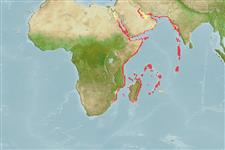>
Eupercaria/misc (Various families in series Eupercaria) >
Labridae (Wrasses) > Corinae
Etymology: Macropharyngodon: Greek, makros = great + Greek, pharyngx = pharynx + Greek,odous = teeth (Ref. 45335).
More on author: Smith.
Environment: milieu / climate zone / depth range / distribution range
Οικολογία
Θαλασσινό(ά) Υφαλόφιλο(α); μη μεταναστευτικό(ά); εύρος βάθους ? - 30 m. Subtropical
Western Indian Ocean: from Zanzibar to Mozambique and Aldabra, Sychelles, Réunion, Mauritius and Maldives, South Africa (Kwa-Zulu-Natal), Chagos Archipelago, southern Oman, Rodrigues, and Yemen.
Μέγεθος / Βάρος / Age
Maturity: Lm ? range ? - ? cm
Max length : 13.0 cm TL αρσενικό/απροσδιόριστο; (Ref. 30573)
Short description
Κλείδες προσδιορισμού | Μορφολογία | Μορφομετρία
Ραχιαίες άκανθες (συνολικά) : 9; Μαλακές ραχιαίες ακτίνες (συνολικά) : 11; Εδρικές άκανθες: 3; Μαλακές εδρικές ακτίνες: 11.
Inhabits lagoon and sheltered seaward reefs (Ref. 9710). Occurs singly or in pairs; females often found in small groups (Ref. 9710). Feeds on invertebrates by picking items from the substratum. Burrows in the sand at the sign of danger (Ref. 5503).
Life cycle and mating behavior
Γεννητική Ωρίμανση | Αναπαραγωγή | Γεννοβολία | Αβγά | Γονιμότητα | Προνύμφες
Oviparous, distinct pairing during breeding (Ref. 205).
Randall, J.E., 1978. A revision of the Indo-Pacific labrid fish genus Macropharyngodon, with descriptions of five new species. Bull. Mar. Sci. 28(4):742-770. (Ref. 2694)
IUCN Red List Status (Ref. 130435: Version 2024-1)
Threat to humans
Harmless
Human uses
αλιεία: χωρίς ενδιαφέρον; Ενυδρείο: Εμπορικό(ά)
Εργαλεία
Special reports
Download XML
Διαδικτυακές πηγές
Estimates based on models
Preferred temperature (Ref.
123201): 24.9 - 29.1, mean 27.5 °C (based on 716 cells).
Phylogenetic diversity index (Ref.
82804): PD
50 = 0.5002 [Uniqueness, from 0.5 = low to 2.0 = high].
Bayesian length-weight: a=0.00977 (0.00466 - 0.02049), b=3.07 (2.90 - 3.24), in cm total length, based on LWR estimates for this (Sub)family-body shape (Ref.
93245).
Τροφικό Επίπεδο (Ref.
69278): 3.5 ±0.37 se; based on food items.
Ελαστικότητα (Ref.
120179): Υψηλό, ελάχιστος χρόνος για διπλασιασμό πληθυσμού < 15 μήνες (Preliminary K or Fecundity.).
Fishing Vulnerability (Ref.
59153): Low vulnerability (10 of 100).
Nutrients (Ref.
124155): Calcium = 61.2 [28.2, 137.5] mg/100g; Iron = 0.763 [0.403, 1.577] mg/100g; Protein = 19.2 [16.3, 21.4] %; Omega3 = 0.247 [0.135, 0.449] g/100g; Selenium = 10.6 [4.9, 22.7] μg/100g; VitaminA = 91.9 [25.8, 418.7] μg/100g; Zinc = 1.19 [0.72, 2.07] mg/100g (wet weight);
